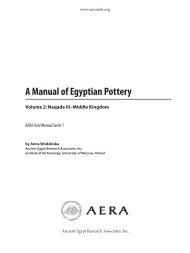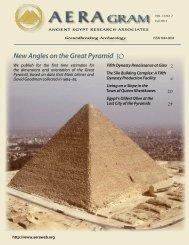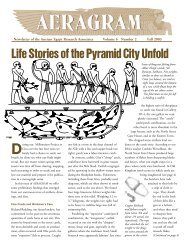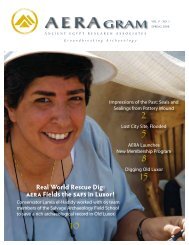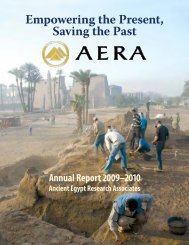The Khentkawes Town (KKT) - Ancient Egypt Research Associates
The Khentkawes Town (KKT) - Ancient Egypt Research Associates
The Khentkawes Town (KKT) - Ancient Egypt Research Associates
Create successful ePaper yourself
Turn your PDF publications into a flip-book with our unique Google optimized e-Paper software.
www.aeraweb.org<br />
16.53 m asl. With an elevation of the bedrock edge at the<br />
causeway threshold of 18.44 m, we have a vertical drop<br />
to a lower bedrock terrace of nearly 2 m. This discovery<br />
only increased the mystery of how one ascended from the<br />
lower terrace, or the floor of the buried building, up to the<br />
beginning of the causeway.<br />
Two Missions Before<br />
Selim Hassan’s men continued to trench farther south<br />
of the causeway to find the extent of the bedrock face,<br />
which decreases in height because the bedrock dips in<br />
this direction, and to track the buried building. But their<br />
work obviously stopped, and the sand drifted in, before<br />
their findings east of the <strong>KKT</strong> received enough attention<br />
to enter the cartographic and published record. We see<br />
indications that either Hassan’s team, or that of another<br />
mission, returned to this area, <strong>KKT</strong>-E, before we began our<br />
work.<br />
When Yeomans cleared east of the <strong>KKT</strong>, the sand to<br />
the north was soft and clean, but the sand to the south<br />
was very compact, tinted brown, with many scattered<br />
limestone chips (fig. 34). <strong>The</strong> surface of both sandy layers<br />
slopes, like the bedrock underneath, from north-northwest<br />
to south-southeast, a dip toward the wadi between the<br />
Moqattam and Maadi limestone formation outcrops at<br />
Giza. This brown crusty sand is a mixture of wind-blown<br />
sand and silt eroded off the <strong>KKT</strong> mudbrick walls after<br />
Hassan’s excavation. <strong>The</strong> scattered limestone chips derive<br />
from the erosion of the quarry faces and rock-cut tombs<br />
to the northwest. <strong>The</strong> prevailing northwest wind blew<br />
this material into the deeper area down the slope to the<br />
southeast.<br />
Except for her deep trenches Yeomans leveled off her<br />
clearing of the sand slightly lower than the quarry edge<br />
on which runs the eastern wall of the <strong>KKT</strong>. For one reason,<br />
just at this level in our square 201.D36 her clearing exposed<br />
a plaster patch [29,856], about 30 × 30 cm, in which a<br />
wooden stake had been set with a thin nail or pin—clearly<br />
someone’s survey marker at elevation 18.12 m asl (fig. 36).<br />
In 2007 we located a series of similar markers across the<br />
top of the mound of quarry debris that rises between the<br />
GIII.VT and <strong>KKT</strong> leg. As we mapped these markers, we<br />
assumed they were Selim Hassan’s grid points of 1931–1932<br />
(fig. 35).<br />
Yeomans’ deep southern trench (fig. 29) was almost<br />
exactly along the lines of at least two earlier trenches,<br />
dug through the sandy overburden by people who, like<br />
Yeomans, were investigating the mudmass and mudbrick<br />
wall underneath. In the south-facing section of her trench<br />
we could see the cut lines and fill of the previous two<br />
trenches. Someone, probably from Selim Hassan’ crew,<br />
dug the earliest of these through clean sand. Someone else<br />
excavated the later trench, almost but not quite along the<br />
same lines, after the brown crusty sand had accumulated<br />
in a layer 25-cm thick (the evidence being that they had<br />
to cut through this layer which had accumulated in the<br />
interval between the two excavations). Big brick-like<br />
chunks of this compacted combination of <strong>KKT</strong> silt and<br />
sand had fallen into the trench when it was backfilled after<br />
the second excavation. Yeomans’ 2007 clearing left a thin<br />
layer of the same material over the cut lines of the second<br />
trench. <strong>The</strong> plaster, wood, and nail survey marker, survey<br />
point no. 13721 (fig. 35) had been set at this level, after<br />
only a little bit more of a layer of the crusty material had<br />
accumulated. If Selim Hassan’s men dug the first trench,<br />
who excavated the second trench before Yeomans dug the<br />
third trench along this same line<br />
We cleared the brown crusty sand in the lower<br />
southern part of Area <strong>KKT</strong>-E (about 15 m east-west × 30<br />
m) in several passes, roughly corresponding to surfaces<br />
that had remained exposed for some time (fig. 34). It was<br />
only after we cleared all the brown crusty sand down<br />
to the surface of the underlying, softer, clean sand that<br />
we exposed the southernmost of a series of gray cement<br />
supports for iron posts. <strong>The</strong> cement supports of this series<br />
in the north were exposed before we excavated the brown<br />
crusty sand because the clean sand rose high there, and<br />
remained unencumbered with the brown crusty sand. But<br />
the southern cement post bases were several centimeters<br />
lower than the plaster and wood survey marker, which<br />
the brown crusty sand had buried. We imagine that these<br />
cement bases were for the wire fence erected east of the<br />
<strong>KKT</strong> excavations shortly after or during Hassan’s 1931–1932<br />
excavations.<br />
Again, it appears either that Selim Hassan’s crew<br />
returned for more investigative digging in a later season,<br />
or the crew of a later mission probed through the sandy<br />
overburden to investigate the ruins of the buried building,<br />
a mission that intended a wide survey over the greater site,<br />
as witnessed by the survey markers over the central mound<br />
of quarry debris (figs. 35–36). It may be that the former<br />
explanation is correct, for this fits with other evidence<br />
that Hassan’s map of the <strong>Khentkawes</strong> monument, the<br />
<strong>KKT</strong>, and the GIII.VT, which has formed the basic template<br />
and record of the site for <strong>Egypt</strong>ologists, was surveyed<br />
late, some years after his excavation was concluded. We<br />
know that Selim Hassan’s mission continued at Giza<br />
through 1938, six years after he discovered the <strong>KKT</strong>. We<br />
have even speculated that the map was based to some<br />
extent on the Royal Air Force (RAF) aerial photograph<br />
of the Giza Necropolis that is part of the MFA Reisner<br />
Archive (http://www.gizapyramids.org/code/emuseum.<br />
aspnewpage=visualsearch). <strong>The</strong> aerial photography<br />
was taken in 1936, four years after Selim Hassan’s team<br />
excavated <strong>KKT</strong>. This might explain why we have found a<br />
few of the plaster and wood survey markers on mudbrick<br />
38<br />
Giza Plateau Mapping Project Season 2008 Preliminary Report





